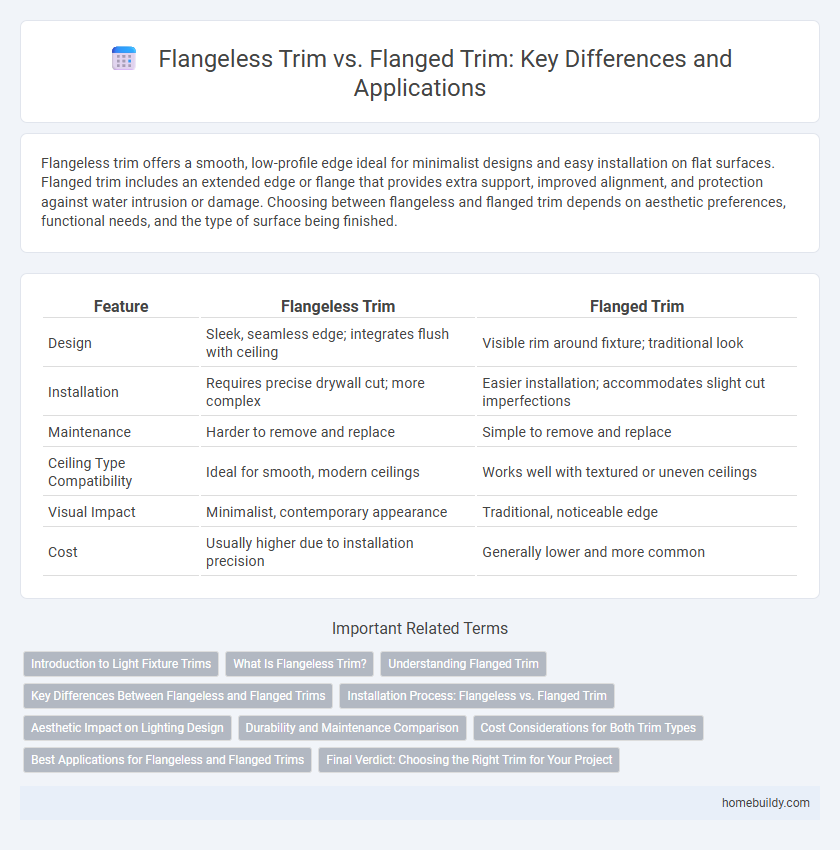Flangeless trim offers a smooth, low-profile edge ideal for minimalist designs and easy installation on flat surfaces. Flanged trim includes an extended edge or flange that provides extra support, improved alignment, and protection against water intrusion or damage. Choosing between flangeless and flanged trim depends on aesthetic preferences, functional needs, and the type of surface being finished.
Table of Comparison
| Feature | Flangeless Trim | Flanged Trim |
|---|---|---|
| Design | Sleek, seamless edge; integrates flush with ceiling | Visible rim around fixture; traditional look |
| Installation | Requires precise drywall cut; more complex | Easier installation; accommodates slight cut imperfections |
| Maintenance | Harder to remove and replace | Simple to remove and replace |
| Ceiling Type Compatibility | Ideal for smooth, modern ceilings | Works well with textured or uneven ceilings |
| Visual Impact | Minimalist, contemporary appearance | Traditional, noticeable edge |
| Cost | Usually higher due to installation precision | Generally lower and more common |
Introduction to Light Fixture Trims
Light fixture trims enhance both the aesthetics and functionality of recessed lighting by providing a clean transition between the fixture and the ceiling. Flangeless trims create a seamless, minimalistic look by sitting flush with the ceiling surface, making them ideal for modern, streamlined designs. Flanged trims, featuring a visible border, offer easier installation and additional coverage for imperfect ceiling cuts, ensuring a polished finish.
What Is Flangeless Trim?
Flangeless trim is a type of light fixture trim designed without the traditional visible flange, allowing the fixture to sit flush with the ceiling surface for a sleek, minimalist appearance. This trim creates a seamless transition between the light and ceiling, reducing shadows and increasing aesthetic appeal in modern interiors. It is ideal for drywall ceilings where a clean, integrated look is desired, providing flexibility in design without the bulkiness of flanged trim.
Understanding Flanged Trim
Flanged trim for light fixtures features an extended edge that overlaps the ceiling surface, providing a clean and finished look while concealing any gaps around the fixture. This design simplifies installation by offering a secure mounting surface and helps prevent light leaks and dust infiltration. Flanged trims are especially beneficial in retrofit projects where precise ceiling cuts are challenging to achieve.
Key Differences Between Flangeless and Flanged Trims
Flangeless trim features a minimalist edge that sits flush with the ceiling, providing a sleek, modern look and seamless integration ideal for contemporary interiors. Flanged trim includes a visible rim that overlaps the ceiling surface, offering easier installation and better concealment of imperfect cutouts. Choosing between flangeless and flanged trims depends on aesthetic preference, installation precision, and the desired level of ceiling integration.
Installation Process: Flangeless vs. Flanged Trim
Flangeless trims require precise ceiling cut measurements and often demand a drywall lip or painting edge for a seamless, flush finish, simplifying installation by eliminating the need to align the flange with the ceiling surface. Flanged trims include a surrounding lip that overlaps the ceiling material, allowing easier alignment and coverage of imperfect cuts but may require additional effort to paint or finish for aesthetic consistency. Installation of flangeless trims suits new builds or remodels with clean-cut ceilings, while flanged trims provide versatility in retrofits or uneven ceiling surfaces.
Aesthetic Impact on Lighting Design
Flangeless trim offers a sleek, minimalist appearance by eliminating the visible edge, creating a seamless integration with the ceiling that enhances modern lighting designs. Flanged trim, with its distinct border, provides a traditional look that can add definition and character to recessed fixtures. The choice between flangeless and flanged trim significantly influences the visual impact, with flangeless trims promoting a clean, unobtrusive aesthetic and flanged trims contributing to a more framed and prominent lighting effect.
Durability and Maintenance Comparison
Flangeless trim offers a sleek, flush installation that reduces dust and dirt buildup, resulting in easier maintenance and longer-lasting cleanliness compared to flanged trim. Flanged trim, while providing a more traditional look with a visible edge, can accumulate grime along the flange, requiring more frequent cleaning and potentially compromising durability over time. Materials like aluminum or steel in both types influence durability, but the simpler design of flangeless trims typically facilitates better longevity with minimal upkeep.
Cost Considerations for Both Trim Types
Flangeless trim typically incurs higher installation costs due to the need for precise drywall finishing and additional labor to achieve a seamless look. Flanged trim, often made from cheaper materials, offers a lower upfront cost and easier installation but may require more maintenance. Evaluating the total cost of ownership, including installation complexity and potential repairs, is critical when choosing between flangeless and flanged light fixture trims.
Best Applications for Flangeless and Flanged Trims
Flangeless trim is ideal for modern, minimalist designs where a clean, seamless ceiling appearance is desired, making it perfect for upscale residential or commercial spaces focusing on aesthetics. Flanged trim offers easier installation and better ceiling protection, suited for retrofit projects or ceilings with irregular surfaces, ensuring a secure and durable fit. Choosing between flangeless and flanged trims depends on the balance between design preferences and installation practicalities in lighting fixture applications.
Final Verdict: Choosing the Right Trim for Your Project
Flangeless trim offers a sleek, minimalist look by sitting flush with the ceiling, ideal for contemporary designs and seamless integration. Flanged trim provides easier installation and better coverage for uneven ceiling cuts, making it a practical choice for retrofit projects and spaces requiring a more forgiving fit. Evaluate the aesthetic goals and installation conditions of your project to select the trim style that balances visual appeal with functional demands.
flangeless trim vs flanged trim Infographic

 homebuildy.com
homebuildy.com